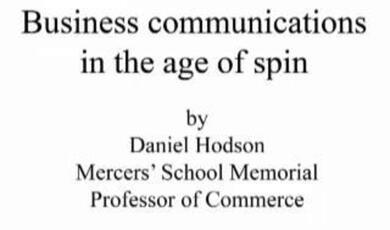Socially Responsible Investment
Share
- Details
- Transcript
- Audio
- Downloads
- Extra Reading
Will the growth of Socially Responsible Investment (SRI) support capital flows to emerging markets or hinder them?
Download Transcript
Socially Responsible Investment
Professor Avinash Persaud
Introduction
We live in a tense world. More palpably tense than at any time since October 1963. Often at the centre of these tensions, is the depth of economic despair that exists in so many places in our world. If these tensions are to be diffused in the long-run, not simply transferred or held over, but sustainably reduced, it will not be through more tanks, but through more opportunity. This is my last lecture of the academic year. Over the past year we have touched on the more glamorous debates in finance, EMU, Credit Derivatives, the folly of VaR, the capture of regulators by investment bankers, but in my view, none is more important than the private financing of development. Much is at stake. Socially Responsible Investment has a role to play in this financing and that is the subject of today’s lecture.
I will be showing you presenting you with some data that most of you will never have seen before and so I must begin by thanking Stephen Spratt and Chris McCoy for some excellent background research.
There are a great many misperceptions in finance. Some are intentional some are not. Here is one of them. Ask the average person, who are the owners of the biggest pools of capital, and they would probably conjure up a mental picture of a mean-streaked capitalist, wearing braces, a cigar, and a disregard for whether his profits are derived from the toil of child labourers in India, or the desecration of the Amazon rain forest. But the answer is more prosaic. It is public employees’ pension funds and ordinary insurance policy holders. The biggest single pool of capital in the world is the $144bn owned by the Californian public employees pension fund, Calpers. The second biggest pool is the $130bn pension fund of Dutch civil servants and teachers, ABP.
Chart 1: Table of the top ten pension funds in the world
The top eight pensions funds in the world are all public employee pension funds. At the end of last year, these eight controlled over $850bn of assets. Incidentally, the General Motors pension fund is the ninth biggest pension fund in the world and the biggest corporate pension fund. World-wide, pension funds control over $5trn of assets and public pension funds control $3trn of that. The assets of general insurance companies are even greater at $11trn. Once you start talking about large numbers like these it is easy to lose perspective, the value of equity holdings can also be somewhat volatile, so it is best to think in terms of ratios. The combined assets of pension funds and general insurance companies world-wide are ten times the entire value of the UK stock market and are about one and a half times the value of the US stock market.
One of the reasons why this is interesting is that the assets of public employee pension funds are owned and controlled, in general, by people deeply concerned about a wider set of issues than investment returns. It may seem a glib generalisation, that those who have selected careers in which money is not the primary reward also wish it not to be the deciding factor in allocating the assets of their pension and insurance funds. Those less burdened by conscience would say there was something of a doubling up of a losing bet about this, but this tendency, to consider social considerations during the pursuit of superior investment returns, is strong. In 1983, two years before the declaration of a State of Emergency by the Apartheid regime in South Africa, the state pension funds in Massachusetts, were barred from investing in any company that did business in South Africa. This move was followed by the two largest pension funds in the US at the time, the Californian State and New York City pension funds. Even in 1983, these three pension funds controlled over $75bn. It was a significant step in the road towards peaceful change in South Africa.
That was twenty years ago. The idea of investing with a social conscience is not a new and transient fashion. It is old, very old, as old as religion. And there are a myriad of connections between the two. For a long-time most socially responsible investment was conducted by religious foundations and related to religious views of what was the right and wrong way to profit. There is no drought of religious views on profit. The origin of the prohibition on usury in both the Bible and the Koran relates to a distaste for profiting excessively from the debts of the poor. In The Use of Money, a sermon published in 1760 by John Wesley, the founder of Methodism, he argues that investors should seek the best returns for their investments, but only from activities that…..did not hurt our neighbour in body or soul. In 1928, one of the first Socially Responsible Investment or SRI funds was established in the US as a result of pressure from temperance societies. It was called the Pioneer Fund and it screened out investments in tobacco or alcohol related companies.
In more modern times when investment came to be seen as a specialty run by dedicated professionals, the principal obstacle to the take up and spread of SRI beyond religious foundations was the concern that restricting the investment universe on the basis of social considerations, or any other consideration for that matter, would worsen an investors potential risk-return trade-off. There is a compelling logic to this Markovitzian view of the world, and it was given legal force by two rulings in the UK courts, Cowan versus Scargill in 1984, and the Bishop of Oxford versus the Church Commissioners in 1990. These rulings effectively ruled out the consideration of non-financial issues by trustees of pension funds and restricted their take up in the UK to church and charity foundations.
Chart 2: Annualised relative performance of SRI indices versus FTSE All Share Index, 1990-1999.
From the early days, however, proponents of SRI funds have been able to show that despite restrictions to the investment universe, SRI funds can outperform the wider market and often does. Throughout the 1990s almost all SRI indices measured by The Ethical Investment Research Service, EIRIS, out-performed the FTSE all share index. It is sometimes argued that this outperformance comes with added risk: that an SRI funds tend to be overweight particular sectors and smaller companies and such a strategy would deliver higher returns with or without an SRI screen but only with higher risks. However, a recent econometric study by brokers West LB Panmure concluded that after adjusting for size, sectors and style factors, the SRI investment style produced an additional annual return of 2.1% in the 1990s. It would appear that sustainability pays off in the long run - which sounds like a tautology, but one that had to be proved.
The Panmure study treats SRI has just another investment style underscoring the point that investors have long used different approaches and styles that impose restrictions on their investment universe in the search for better returns. Less is more. Partly as a consequence of the returns record, legal opinion began to soften. Investments could be screened out on socially responsible grounds as long as there were sufficient, equally profitable, alternatives.
This helped the SRI cause, but an even more significant change occurred in 1999, when the Labour government amended the previous administration’s 1995 Pension Act so that pension funds were required to set out in their annual report the manner, if any, that social and environmental factors were taken into account in their investment decisions. This marked the end of an important passage that began with the consideration of non-financial issues in the asset allocation of pension funds being illegal, to where the onus was on those who did not take social and environmental issues into account, to explain why.
A related but separate development was the thought, gathering in acceptance, that insurance companies, casualty insurers in particular, are in some sense long environmental and social risks - like asbestos or tobacco related claims - and that one way to off-set and hedge these risks is for them to be long SRI assets. This is best illustrated by thinking of an environmental disaster. The share price of companies adversely exposed to the disaster would fall relative to those less exposed, or perhaps even in the business of cleaning up the disaster. The share prices of environmentally responsible companies ought to be negatively correlated with environmental disasters. In October 2001, the Association of British Insurers (ABI) issued guidelines for its members encouraging them to formalise processes to deal with the risks and opportunities arising from socially responsible and environmental issues, and to disclose the practice of these processes.
Chart 3: UK, SRI assets, 1997-2001
It is early days, but it would appear that these directives, on pension funds and insurance companies, have dramatically altered the landscape of SRI in the UK. Instead of being the preserve of the village tea party set, SRI has now scaled the walls of more mainstream pension funds and insurance company assets. In the UK, SRI assets leapt ten-fold in four years to $326bn in 2001, made up primarily of assets owned by pension funds and insurance companies. In 1997, the total was just $30bn, made up almost entirely by assets owned by churches and charities. In the US, church and charity foundations are much larger than in the UK and the legal obstacles to SRI were never so high. From this much stronger base, recent growth has been enviable, but not so dramatic.
Chart 4: Global SRI assets, 2001
SRI assets in the US doubled in four years to $2.3trn in 2001. The UK, US and Netherlands dominate the pension fund industry, but there has also been growth elsewhere, especially in Canada. Dwell on this figure. By the end of 2001, SRI assets around the world had reached $2.7trn, almost twice the entire value of the UK equity market.
In 1984, when Friends Provident, a Quaker owned financial institution, established the Stewardship Funds, which screened out investments that they considered unethical, the hard-nosed bankers of the city nick-named it, the Brazil Fund, on the basis, that it was nuts. It was widely felt back then, and still in some quarters today, that Socially Responsible Investment would be an insignificant market niche with no influence on mainstream investment practice. The reality is that investors who look favourably upon SRI own the world’s largest pools of capital, that SRI has grown rapidly and will probably continue to do so, and that it is already very large.
SRI & Global Development
I will now like to turn to the impact of SRI, especially in relation to the global economy and developing countries.
At the very least SRI has changed our TV commercials. In the old days an advert about an oil company would have lots of man-eating mammals leaping about, now they have earnest looking scientists in yellow anoraks taking soil samples. I am not sure it matters whether they are motivated by a genuine love for mother earth or just their own image, the point is that oil companies and companies in other extractive industries have spent large amounts of money on socially and environmentally responsible activities. Earlier the divestment campaign by public pension funds against South-African related companies played a role in toppling the Apartheid regime. Today, share holder pressure shapes the actions of companies far more so than before. In 2001 there were 251 shareholder resolutions filed in the US on SRI issues, 40% of which were on environment related issues. But socially responsible investing has so far had little impact on developing countries.
Chart 5: Key Issues for SRI Investors and SRI Screening categories
The biggest mismatch between what SRI trustees say they are concerned about, and what they end up screening for in their investments is in the area of promoting global development. In the most recent survey in the UK, SRI trustees say this is the most important issue to most of them – see the left hand column where concerns are ranked from most common to least. Joint first is fair employment practices, then a couple down is the environment. Employment practices and the environment feature in 50% of SRI funds as screens for determining which companies they invest in. However, only 3% of funds screen for companies whose activities would be beneficial to global development and only 7% screen out companies whose activities appear harmful to global development.
SRI trustees want to invest in environmentally responsible companies or screen out those that are irresponsible and they do. They want to invest in globally responsible companies that support communities in poor countries or screen out those that are irresponsible, but they do not. If they did it would have enormous impact. If just 10% of the new money flowing into SRI assets flowed to emerging markets, it would not double or triple the annual flow of equity finance to emerging markets, but increase it by four or five-fold. Of course given the limited capacity in these markets, this could not happen overnight.
Chart 6: Pension Fund Trustees Attitudes on Short-term (1-year) Impact of SRI issues on Share Prices
There are two reasons for this mismatch. The first comes back to the fine balance between the pursuit of profit and the pursuit of a clear conscience. There is a belief, encapsulated in these surveys, that investing in companies that have good employment and environment practice is not only socially responsible, but also good for business and hence for the share prices of these companies and ultimately the value of the pension fund. Consequently, screening companies on these considerations can be presented as sound business and investment practice. Investing in companies that support global development in their locations, choice and treatment of suppliers and contribution to sustaining local communities in the developing world, is not seen as a supporting factor for share prices. This helps to explain the near absence of funds that screen for companies that support or at least do no harm to global development. But it is an explanation that rests on a belief that may be wrong or at least inaccurate.
I am not going to argue that if a company is globally responsible in its location, choice of suppliers and relationship with its community, that this will be good for its business and will boost its share price. Though, I would not exclude this possibility. Consumers like to buy products they feel good about. A separate yet related point is that investing in globally responsible companies, especially those in emerging markets, may add some powerful diversification to an investment portfolio, improving its overall risk-return trade-off.
Chart 7: Correlation matrix using the past ten years of daily correlations of equity returns between emerging markets and developed markets.
Following in the foot prints of some very intriguing work by Stephany Griffth-Jones, Miguel Segoviano and Stephen Spratt – who I think I see all here today - Chris McCoy and I have looked afresh at short and long-run co-variances of 10 emerging and 10 developed equity markets. Those of you who have attended my other lectures will know that I am sceptical of the stability of the statistical properties of markets over short periods. So to try and capture the structural relationship between markets we have estimated co-variances using 15 years of weekly data. The results are summarised in these two matrices. At first, this confirms the consensus view that emerging markets are highly correlated with each other and more so than developed markets. Look at the right hand table and compare the numbers in the top left hand quadrant with those in the bottom left quadrant. This of course is even more apparent when a crisis strikes. Somewhat counter-intuitively these co-variances are greater over the long run, using three year returns, that’s the right hand matrix, than over the short-run using weekly returns, the left hand matrix. But now look at the top right hand and bottom right-hand quadrants of each matrix. They show that over either time period, emerging markets are less correlated with developed markets than developed markets are with themselves. This is a critical observation. In other words a pension fund that only invested in companies in developed markets would have a less diversified portfolio than if it invested in companies from developed and emerging markets.
This result echo’s the result of the Griffith-Jones study which obtains the same result using bank loan data rather than equity market indices. If a company decided to promote global responsibility, it may not improve its share price by doing so, however, adding such companies to your portfolio, will improve the risk-return trade-off of the portfolio, which means that your returns are higher for a given level of risk.
The second obstacle to the greater use of global development screens in SRI relates to information costs. Screening out tobacco companies is easy. Screening for companies that are globally responsible is much more complex. This is one of the last places where information costs, such as collecting, collating and defining data, have not collapsed to zero.
It is a problem amplified by the fact that developing country markets are generally small and their average constituent company is small. An investor trying to make sure that they did not own an excessive proportion of any one company would have to spread their investments over a far larger number of companies in a small emerging market than in a larger developed country markets. Researching a large number of small companies, that few others are interested in, in markets where political and economic risks are high, variable and uncertain, is clearly far more costly than researching a small number of large companies in developed markets that everyone else is interested in. Incidentally this information premium means that, separate from the SRI issue, there are many well run, successful companies in developing countries which offer persistently high dividend yields.
To make matters worse information is your classic public good where the set up and fixed costs are large, but with the advent of the internet, the marginal costs of distributing the information are close to zero. Like other public goods it is not in the interests of private companies to carry out expensive research which could always be delivered more cheaply by a competitor. Public goods tend to be delivered by monopolies that can control supply and price so there is a market for one or two providers but not many. And there is another problem. Defining a tobacco company or an armaments company is not straight forward, but it is much easier to do so than defining a company that supports global development. What is good or bad for development is a contentious issue, open to debate. In these circumstances who makes the definition, their credibility and reputation becomes as important as the definition itself. The organisations already in the screening business do not have credibility or reputation in the development business.
It is hard to see these information market failures being easily solved by the existing participants.
One possible intervention is for an institution that has credibility amongst business as well as the development lobby, and expertise in developed as well as developing countries to establish a set of guidelines that provide a screen through which companies that promote or do not harm global development can be identified. The actual screening might then be carried out by one of the existing screening organisations or perhaps even one of these new, low-cost-internet-based research groups setting up around Bangalore. There are few institutions that can do this, but it is an interesting challenge. One that could galvanise substantial flows in the name of what I would call, Globally Responsible Investment, to differentiate this from the emphasis of most existing SRI funds on environment and corporate governance mandates and developed country markets.
Conclusion
We have made three points this evening. First, Socially Responsible Investing is not nuts. It has grown rapidly, beyond its traditional base in the church and charity sectors. Recent directives on pension funds and insurers may accelerate this growth still further, but whether it does or doesn’t, $3trn of SRI assets is already a highly significant pool of capital.
Secondly, SRI investors say global development is a key social concern for them, in the most recent survey, they say it is the most important concern, yet it is near the bottom of factors they end up screening for.
There are a couple of reasons for this. There is a view that promoting global development may be a good thing but it will not improve the bottom line as much as other good things such as looking after the environment or using good employment practices. Further, screening for companies in emerging markets or those that promote global development is harder and more costly.
However, we have also shown that adding developing countries to a portfolio of developed markets will bring diversification benefits, in the short-run as well as the long-run. This adds to the case that if an institution with credibility in both the business and development space were to provide screens that helped investors identify companies that promoted global development, they would be used. Better awareness of the supply will create its own demand.
Chart 8: Bar chart on the financing of emerging markets
At the beginning I said much was at stake, and the benefits of the increased flow of private-sector equity flows are even more significant that often appreciated. It would for a start steady the flow of capital from developed to emerging markets. Bank loans and bond flows are particularly volatile sources of funding for countries and companies where default risks are significant and variable. Indeed, it has also struck me as a little odd that the principle source of financing in developing countries is via bonds and loans when equity flows would better share the risks.
The risk sharing attribute of equities has other advantages too. Let me end with a true anecdote. The September 11 tragedy had a significant emotional impact on an acquaintance who is chairman of a US publicly quoted company. He was overcome with a desire to do something and felt on reflection that he should devote his energies to supporting global development through trade and championing the freer movement of exports from developing countries. He wrote a few articles and began to speak more loudly on the issue. He soon got a phone call from the trustee of a large pension fund who owned a sizeable chunk of his company, the trustee said the trade union representative on the their board was not pleased about his stance, it was going to cost American jobs. They were reconsidering their investment and the chairman reconsidered his stance.
The trustee felt that their interests lay with those members who were still working and who jobs were under threat form competition. I wondered what would have happened if the fund was more fully invested in emerging markets, if it was in the funds interests that those economies did well. It would have helped to create a domestic political lobby for a more internationally minded policy. If pensioners in developed markets had a greater exposure to the risks of emerging economies, it would be good for emerging economies, it would be good for the long-run returns of those pension funds and it would create a powerful lobby for the global economy, something that is sorely lacking today.
© Professor Avinash Persaud, 2003
This event was on Thu, 20 Mar 2003
Support Gresham
Gresham College has offered an outstanding education to the public free of charge for over 400 years. Today, Gresham plays an important role in fostering a love of learning and a greater understanding of ourselves and the world around us. Your donation will help to widen our reach and to broaden our audience, allowing more people to benefit from a high-quality education from some of the brightest minds.


 Login
Login







